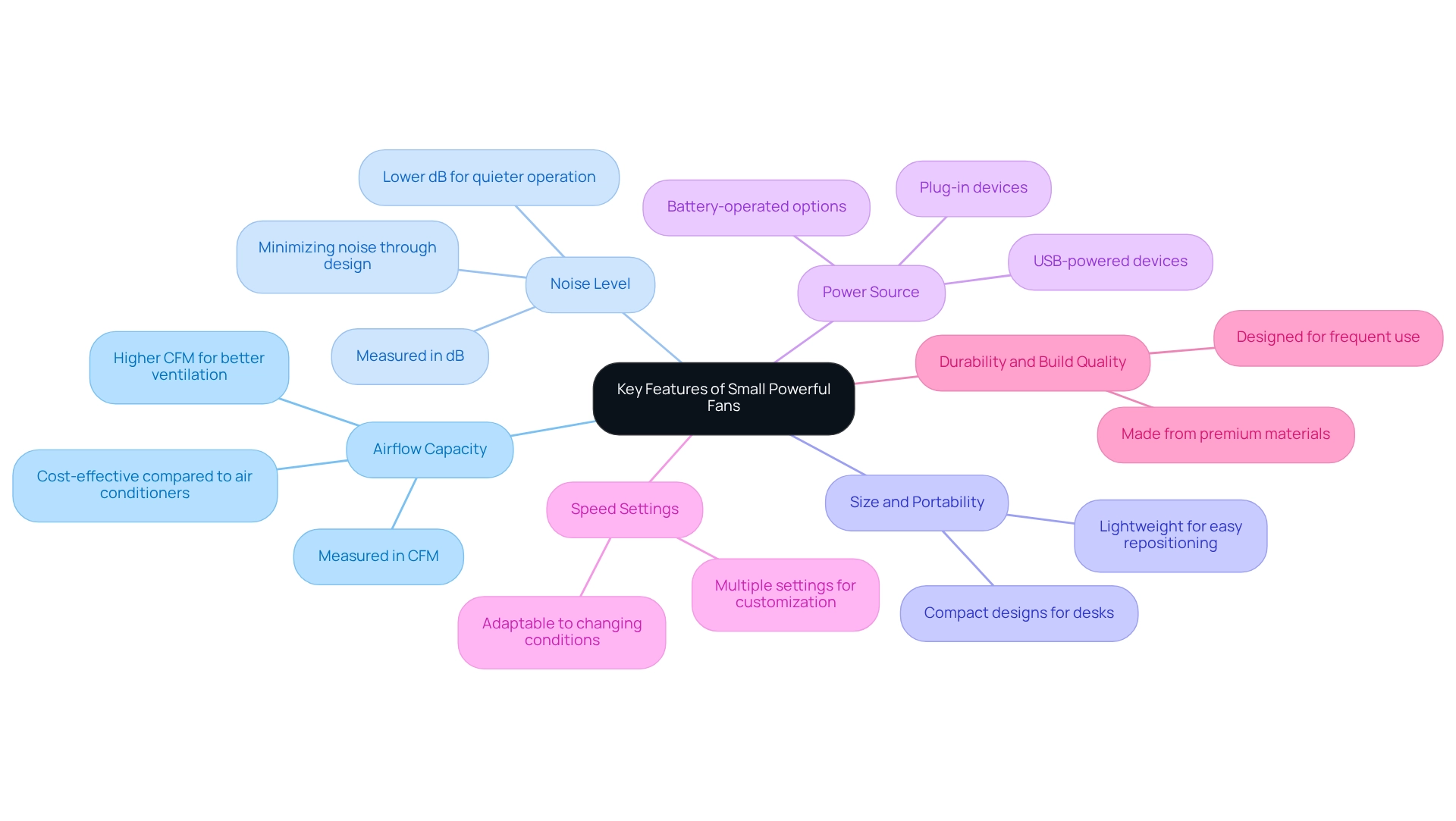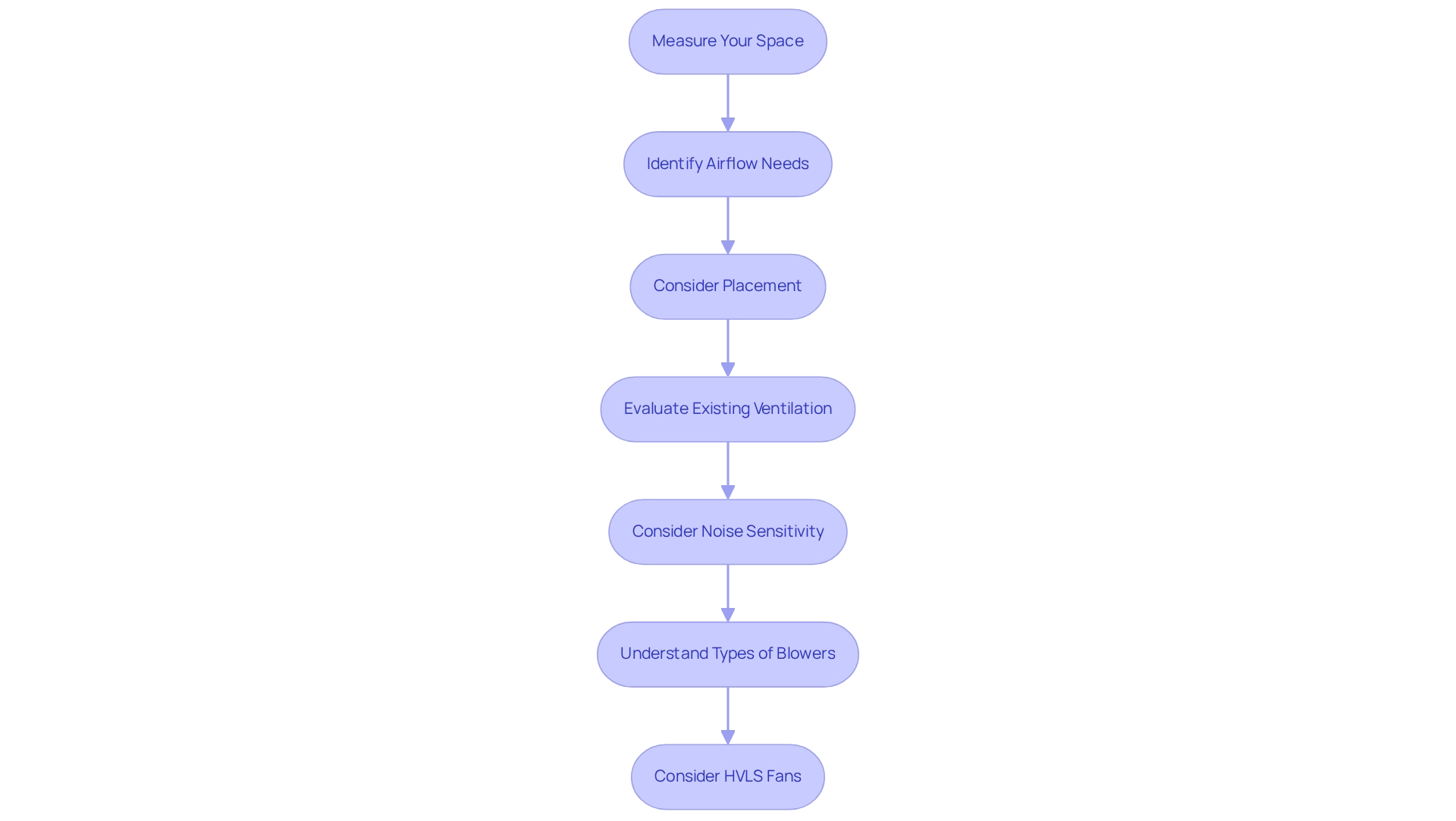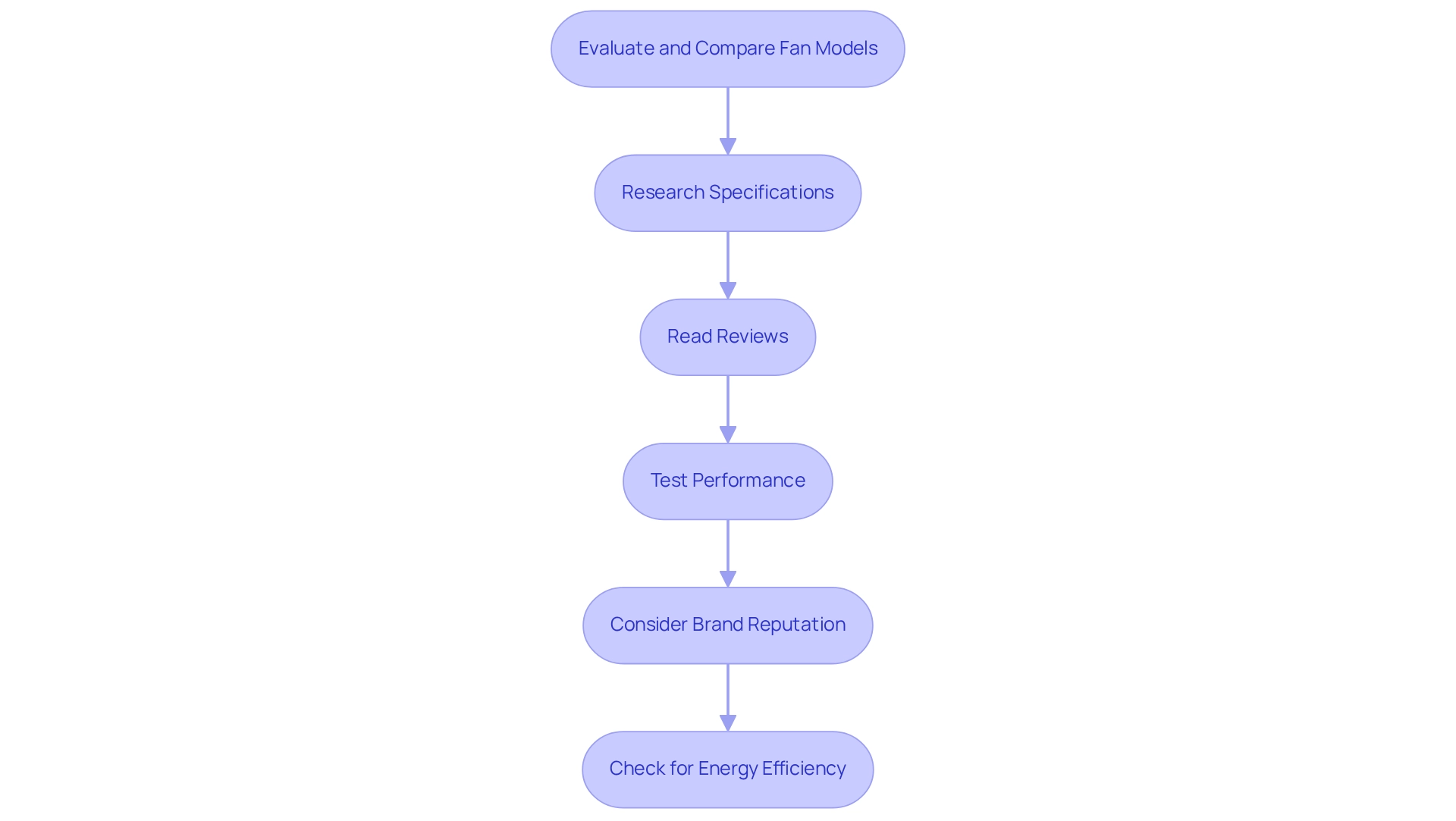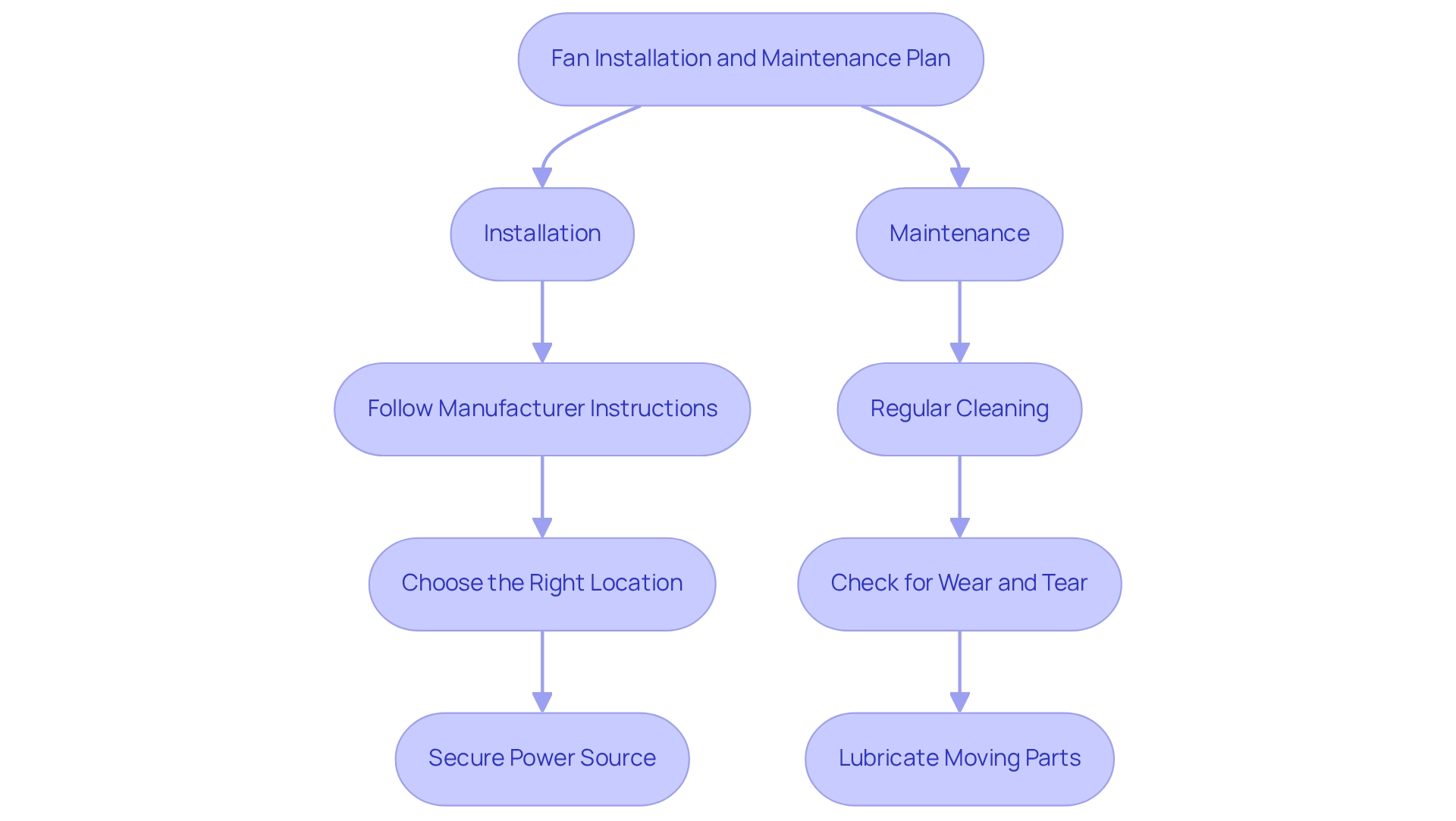Overview
To select the optimal small powerful fan for your workspace, it is essential to prioritize key features:
- Airflow capacity
- Noise level
- Size
- Power source
- Speed settings
- Durability
Recognizing the significance of these factors, along with a thorough assessment of your workspace requirements, can greatly enhance comfort and productivity. This approach ensures that you achieve optimal cooling performance tailored specifically to your needs.
Introduction
In the quest for comfort and productivity within small workspaces, the selection of an appropriate fan is crucial. With a plethora of options at one’s disposal, comprehending the key features that impact performance becomes essential.
- Airflow capacity
- Noise levels
- Portability
- Durability
are all critical factors that contribute to an optimal cooling environment. Moreover, evaluating workspace requirements alongside a comparative analysis of various fan models based on their specifications empowers users to make informed decisions.
This article explores the fundamental criteria for selecting a small yet powerful fan, providing insights into installation and maintenance practices that ensure enduring efficiency and comfort in any workspace.
Identify Key Features for Small Powerful Fans
When selecting a small powerful fan, several key features should be prioritized to ensure optimal performance and comfort:
- Airflow Capacity: Airflow capacity, measured in cubic feet per minute (CFM), is essential for efficient temperature regulation. Fans with higher CFM ratings are favored for use as small powerful fans, as they can move more air and improve ventilation efficiency in small areas. While small powerful fans are typically more affordable than larger temperature regulation options like air conditioners, their efficiency in focused temperature management significantly enhances comfort in work environments.
- Noise Level: The decibel (dB) rating is a crucial consideration, particularly in work environments where concentration is paramount. Fans with lower dB ratings provide quieter operation, minimizing distractions and fostering a more productive atmosphere. Furthermore, reducing unwanted noise can be achieved by lowering system impedance and optimizing fan size and speed.
- Size and Portability: The fan’s dimensions should correspond to your working area. Compact designs are ideal for desks, while a small powerful fan offers lightweight mobility, enabling users to reposition it as needed for optimal cooling.
- Power Source: Evaluate the power source that best suits your workspace. Options include battery-operated, USB-powered, or plug-in devices, each offering varying degrees of convenience and portability.
- Speed Settings: Multiple speed settings allow users to customize airflow according to their comfort levels. This flexibility is particularly advantageous in dynamic work environments where conditions may fluctuate throughout the day.
- Durability and Build Quality: Selecting a small powerful fan made from premium materials ensures longevity and reliable performance. Sturdy appliances can withstand frequent use without compromising their temperature regulation capabilities.
Recent case studies illustrate that desk fans effectively provide focused cooling, making them suitable for specific areas such as desks or beds. This targeted approach not only enhances individual comfort but also contributes to increased productivity in compact spaces. As technology advances, innovations in small fan design continue to emerge, offering engineers a variety of options that balance performance with noise reduction, thereby ensuring a comfortable working environment. Additionally, utilizing an electricity cost calculator can aid in managing electricity usage effectively, simplifying the evaluation of the cost-effectiveness of fan choices. As noted by Johann Tang, a Product Specialist at Oriental Motor USA Corp., “Unfortunately, we do not manufacture a fan with 8,000 CFM output,” underscoring the importance of understanding airflow capacity when selecting a fan.

Assess Workspace Requirements and Constraints
To effectively assess your workspace requirements for fan selection, follow these essential steps:
- Measure Your Space: Begin by determining the dimensions of your workspace—length, width, and height. This measurement is crucial for understanding the volume of air that needs to be circulated, which directly impacts cooling efficiency. Numerous areas for electronics engineers usually vary from 100 to 300 square feet, with ceiling heights averaging around 8 to 10 feet.
- Identify Airflow Needs: Evaluate the number of occupants and the heat generated by equipment in the space. Greater occupancy or heat emission from equipment requires a stronger fan to preserve ideal circulation and comfort.
- Consider Placement: Strategically identify the fan’s location within the work area. Ensure there is adequate clearance for ventilation and that the fan does not obstruct movement or interfere with work tasks, which is vital for maintaining productivity.
- Evaluate Existing Ventilation: Assess whether your area has windows or vents that could influence airflow dynamics. Understanding these factors can significantly affect the type of fan required for effective cooling.
- Consider Noise Sensitivity: If your work area requires a serene atmosphere, prioritize devices engineered for quiet operation. This consideration is particularly important in settings where concentration is key, such as engineering workspaces.
- Understand Types of Blowers: Recognize the differences between industrial and commercial units. Industrial blowers are engineered for heavy-duty uses and generally provide greater airflow rates, whereas commercial models are more economical and appropriate for lighter tasks.
- Consider HVLS Fans: If applicable, consider HVLS (High Volume Low Speed) fans, which differ from residential fans in design and functionality, catering specifically to industrial needs.
By following these steps, you can ensure that the chosen fan meets the specific cooling requirements of your environment, ultimately enhancing comfort and efficiency. Additionally, insights from the case study titled “Longevity of Industrial and Commercial Fans” emphasize the importance of maintenance for ensuring long-lasting performance, thus offering value over time. As Tony Pfenning noted, “Choosing a dust collector design that best suits your needs will guarantee efficient dust collection and removal in your facility.” This knowledge, combined with insights from case studies on workspace measurement, underscores the importance of tailored fan selection to accommodate both equipment heat generation and personnel comfort.

Evaluate and Compare Fan Models Based on Performance
To effectively evaluate and compare small powerful fan models, it is essential to follow a structured approach:
- Research Specifications: Begin by examining the CFM ratings, noise levels, and power consumption of various models. Utilize comparison charts found on manufacturer websites or trusted review platforms to gather this information.
- Read Reviews: Investigate customer feedback regarding performance, durability, and ease of use. Websites such as Wirecutter and Tech Gear Lab offer comprehensive reviews and comparisons that can aid in your decision-making process.
- Test Performance: Whenever possible, assess the devices in-store to directly evaluate their ventilation and noise levels. This hands-on experience can provide valuable insights into how they will function in your workspace.
- Consider Brand Reputation: Research brands that are recognized for their quality and reliability in fan manufacturing. Established brands typically offer superior customer service and warranty options, which can be crucial for long-term satisfaction.
- Check for Energy Efficiency: Prioritize fans with energy-efficient ratings to reduce electricity costs over time. Generally, models equipped with small powerful fans demonstrate greater efficiency compared to those with AC motors.

Plan for Installation and Maintenance of Your Chosen Fan
To ensure your fan operates effectively, it is imperative to adhere to the following installation and maintenance tips:
-
Installation:
- Follow Manufacturer Instructions: Adhering to the installation guidelines provided by the manufacturer is crucial for safety and optimal performance. Studies show that following these instructions can significantly increase installation success rates, thereby reducing common mistakes that often lead to inefficiencies. For instance, statistics indicate that improper installation can lead to a 30% increase in operational issues.
- Choose the Right Location: Strategically place the fan to enhance circulation. Avoid corners or areas with limited airflow, as these can hinder performance. Proper placement is essential for achieving the desired cooling effect.
- Secure Power Source: Ensure the fan is plugged into a suitable outlet and manage any cords to prevent tripping hazards. A stable power source is vital for consistent operation.
-
Maintenance:
- Regular Cleaning: Accumulated dust and debris on fan blades and grills can drastically reduce efficiency. Clean these components regularly with a damp cloth or a vacuum equipped with a brush attachment to maintain optimal airflow.
- Check for Wear and Tear: Periodically inspect the fan for signs of damage, such as frayed cords or loose parts. Promptly addressing these issues can prevent further damage and extend the fan’s lifespan. As highlighted in the case study “Commitment to Action,” clients have successfully reduced their annual utility bills by 15% through diligent maintenance practices.
- Lubricate Moving Parts: If applicable, lubricate the motor and other moving components as recommended by the manufacturer. This practice ensures smooth operation and can enhance the fan’s performance over time. Experts recommend lubrication every six months to maintain efficiency.
By implementing these installation and maintenance practices, you can ensure your small powerful fan operates efficiently and effectively, which contributes to a comfortable workspace.

Conclusion
Selecting the right small powerful fan is essential for enhancing comfort and productivity in compact workspaces. Prioritizing key features such as airflow capacity, noise levels, portability, speed settings, and durability ensures optimal performance. Higher CFM ratings facilitate effective cooling, while quieter models promote concentration. A thorough understanding of workspace requirements—including size, airflow needs, and existing ventilation—further aids in making an informed choice.
Evaluating and comparing various fan models based on specifications and customer reviews enables users to identify the best options tailored to their specific needs. Additionally, proper installation and regular maintenance are critical for maximizing the fan’s efficiency and longevity. By adhering to manufacturer guidelines and consistently maintaining the device, users can significantly enhance their workspace environment.
In conclusion, investing time in selecting the right fan that aligns with individual workspace requirements not only enhances comfort but also boosts productivity. As technology continues to advance, small fans evolve, offering innovative solutions that cater to diverse cooling needs. Making a well-informed decision ensures a more comfortable and efficient work experience, ultimately leading to greater satisfaction and performance in small workspaces.
Frequently Asked Questions
What key features should be prioritized when selecting a small powerful fan?
Key features to prioritize include airflow capacity (measured in CFM), noise level (measured in dB), size and portability, power source, speed settings, and durability/build quality.
Why is airflow capacity important in a small powerful fan?
Airflow capacity is essential for efficient temperature regulation, as fans with higher CFM ratings can move more air and improve ventilation efficiency in small areas, enhancing comfort in work environments.
How does noise level affect the use of small powerful fans in work environments?
The noise level, indicated by the decibel (dB) rating, is crucial in work environments where concentration is important. Lower dB ratings provide quieter operation, minimizing distractions and fostering productivity.
What are the considerations regarding the size and portability of a small powerful fan?
The fan’s dimensions should suit your working area, with compact designs ideal for desks. A small powerful fan should also be lightweight for easy repositioning to achieve optimal cooling.
What types of power sources are available for small powerful fans?
Small powerful fans can be battery-operated, USB-powered, or plug-in devices, each offering different levels of convenience and portability.
Why are speed settings important in small powerful fans?
Multiple speed settings allow users to customize airflow based on their comfort levels, which is especially useful in dynamic work environments where conditions may change throughout the day.
How does durability and build quality impact the selection of a small powerful fan?
Choosing a fan made from premium materials ensures longevity and reliable performance, allowing the appliance to withstand frequent use without compromising temperature regulation capabilities.
What benefits do desk fans provide according to recent case studies?
Desk fans effectively provide focused cooling suitable for specific areas like desks or beds, enhancing individual comfort and contributing to increased productivity in compact spaces.
How can technology advancements affect small fan design?
Innovations in small fan design continue to emerge, offering options that balance performance with noise reduction, ensuring a comfortable working environment.
How can an electricity cost calculator assist in choosing a small powerful fan?
An electricity cost calculator can help manage electricity usage effectively, simplifying the evaluation of the cost-effectiveness of different fan options.

